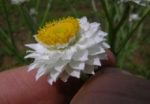 Native to eastern Australia, this tender perennial (often grown as an annual) is a member of the aster family, Asteraceae, that also includes daisies, sunflowers and lettuce. It self seeds and is naturalized in the US where it can be found along roadsides or in woodlands and grasslands. Growing up to 3′ tall, the snake-like stems are silvery green and winged. The gray green leaves are lanceolate to ovate, are up to 6″ long and form a basal rosette 12″ across. Appearing is summer, the papery flowerheads are up to 1.5″ across and consist of white ray flowers surrounding yellow disc flowers. Plants do best in cool climates and do poorly in high heat and humidity especially combined with afternoon rains. They are attractive massed in the garden, fresh in the vase, or dried. The genus name, Ammobium, comes from the Greek words ammos meaning sand and bio meaning live and refers to its native habitat. The specific epithet, alatus, is the Latin word meaning winged and refers to the appendages on the stems.
Native to eastern Australia, this tender perennial (often grown as an annual) is a member of the aster family, Asteraceae, that also includes daisies, sunflowers and lettuce. It self seeds and is naturalized in the US where it can be found along roadsides or in woodlands and grasslands. Growing up to 3′ tall, the snake-like stems are silvery green and winged. The gray green leaves are lanceolate to ovate, are up to 6″ long and form a basal rosette 12″ across. Appearing is summer, the papery flowerheads are up to 1.5″ across and consist of white ray flowers surrounding yellow disc flowers. Plants do best in cool climates and do poorly in high heat and humidity especially combined with afternoon rains. They are attractive massed in the garden, fresh in the vase, or dried. The genus name, Ammobium, comes from the Greek words ammos meaning sand and bio meaning live and refers to its native habitat. The specific epithet, alatus, is the Latin word meaning winged and refers to the appendages on the stems.
Type: Tender perennial often grown as annual or biennial
Bloom: Papery daisy-like flowerheads 1.5″ wide with white ray flowers surrounding yellow disc flowers in summer
Size: 2- 3′ H x 12-15″ W
Light: Full sun
Soil: Average, medium moist, well-drained
Hardiness: Zones 8-10, often grown as an annual or biennial
Care: Low maintenance; cutting flowers encourages rebloom
Pests and Diseases:
Propagation: Seed
Companion Plants: Stokesia laevis, Chrysopsis mariana, Antirrhinum majus
Outstanding Selections:
‘Bikini’ (3/4″ wide flowers, plants 15″ tall; good for small gardens)
‘Grandiflora’
Photo Credit: Wikipedia